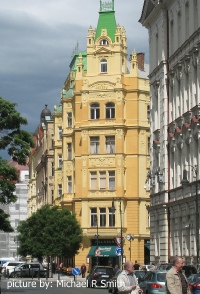
Some of the numbers presented in this website may not be the most recent available
Globalshift.co.uk - copyright © 2009 to 2025; All rights reserved



PRAGUE
Back street
Brief history of the country
Czechia (known as the Czech Republic before 2016) is land-locked, bordered by Germany (west), Austria (south), Slovakia (east) and Poland (northeast).
Beginning around 300 BC tribes from all of Europe settled in the region. In the 8th century the Great Moravian Empire ruled Bohemia until the Czech state was formed as the Duchy of Bohemia in 870, conquering Moravia in 907 and expanding widely. In 1004 it became a Kingdom of the Holy Roman Empire, peaking in the 14th century when Charles IV became Emperor.
In 1526 Bohemia was integrated into the powerful Habsburg Empire but attempted secession from Catholicism. Rebellion in 1620 culminated in decline and loss of land. In 1806 it became part of the new Austrian Empire as an industrial centre but with no autonomy.
An independent Czechoslovakia was formed in 1918 following collapse of the Austro-Hungarian Empire. Slovakia allied itself to Germany in 1939 while Czech areas were occupied. Freed by the Soviets, a coup in 1948 led to a communist state under Soviet influence.
In 1968, during the Prague Spring, it was invaded by the USSR to suppress dissidents but finally became multi-party after the 1989 Velvet Revolution. In 1993 Czechoslovakia peacefully split and market reforms have turned Czechia into a developed country with a strong economy.
Oil and gas summary
Land-locked Czechia comprises the provinces of Bohemia and Moravia and part of Silesia. Bohemia in the west is a basin drained by the Elbe and the Vltava rivers, surrounded by low forested mountains whose highest point is 1,602m. Moravia in the east comprises low forested hills.
An extension of the Vienna basin of Austria within southern Moravia is the site of all of Czechia’s oil and gas production. Sandstones of the Middle and/or Upper Badenian in the north are the most productive of oil. A large depleted field (Hrušky) now serves as underground gas storage. Oil may also be present in the Moravian part of the Carpathian foredeep.
Associated gas is mostly found in the south Moravian part of the Vienna basin but in northern Moravia between Pøíbor and Èeský Tìšín gas accumulations are present in weathered Carboniferous paleorelief.
CBM, of Carboniferous origin, is extracted during degasification of coal seams of the Czech part of the Upper Silesian coal basin.
The first drilling in Moravia within the Vienna Basin occurred in 1900. Some oil shows were found near the village of Hodonin but activity ceased until 1919 when the Moravian Exploitation Company began drilling 12 wells on the Nesyt estate. Small amounts of oil were produced.
During the WW2 Germany took over and the DEA corporation (Deutsche Erdöl A.G.) drilled a large number of wells. After the war the Czech Oil Plants (ÈNZ) residentiary in Hodonin was created with further institutions in other localities maintaining production at around 1,000 bbls per day. These were replaced in 1953 by two new companies which were both shut down in 1989 after the fall of communism.
Output of oil had been relatively flat for many years until a short growth phase began in the late 1990s. New investment led to improved recovery technologies and ouput reached a peak of around 6,500 bbls per day in the early 2000s.
Marketed gas production began in 1956 but production volumes have never been substantial. No significant growth of conventional oil or gas output is expected by Globalshift although some shale gas potential may exist within the Vienna basin. This is unlikely to be exploited for environmental reasons.

CZECHIA
Map and National Flag

Eastern Europe




Capital
Population
Land area (sq kms)
Oil prod (000s b/d)
Gas prod (bcm/yr)
Oil cons (000s b/d)
Gas cons (bcm/yr)
Prague
10.5 mm
78,865
2.8
0.18
197
8
Government
Czechia is a parliamentary democracy. The directly elected president is the formal head of state with limited powers including appointing the prime minister and members of the cabinet. The Prime Minister is head of government.
Parliament is bicameral with a 200-member elected Chamber of Deputies and an 81-member elected Senate.
The Czech Republic joined the European Union in 2004 and officially changed its name to Czechia in May 2016.
The oil and gas industry is overseen by the Ministry of Industry and Trade.
In 1990 a state company of the Moravian Oil Industry was created in Hodonin.



CZECHIA: SEDIMENTARY BASIN
Globalshift.co.uk (source: ResearchGate)